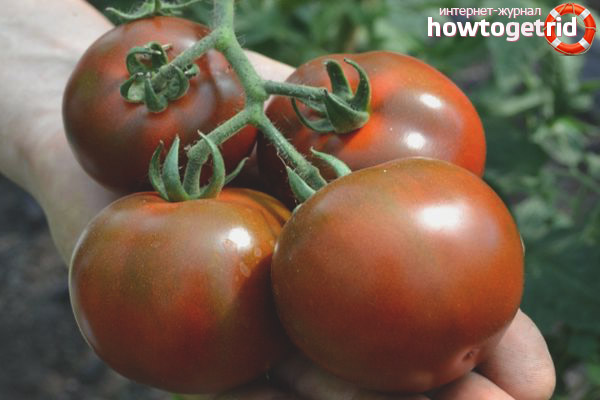The content of the article
Tomato Ashdod F1 is an early hybrid with brown fruits, designed for growing in greenhouses, temporary shelters, open ground. The fruits are characterized by a high content of pigment - lycopene. Ashdod fruits ripen 85 to 90 days after emergence.
Description
Ashdod is an indeterminate hybrid of early ripening. Bushes have unlimited growth. A lot of lycopene, belonging to the group of carotenoid pigments, accumulates in the fruits.
Bushes are strong, with short internodes. The first brush is bookmarked above the seventh sheet. Subsequent brushes are formed through three sheets. Ripe fruits are brown or red-brown. The pulp is very sweet, without acid, saturated dark cherry color. Growing tomatoes Ashdod does not require a lot of labor and time. In itself, this culture is unpretentious.
Features of cultivation: planting and care
To get a good harvest of large, ripe fruits still have to work hard. This crop can be grown both in greenhouses and in open ground. Frequent watering is undesirable. The plant will tolerate drought better than waterlogging. For active growth, one large watering is enough every 5-7 days. In dry periods - once every 3-4 days. Five to seven liters of water are consumed per bush.
For growing seedlings, a box of bars is suitable. It is filled with a fertile soil mixture to a height of 20 cm, taking into account the possible subsidence of the earth. Top cover with glass or film. Seedlings can be grown in a special nursery.
Attention! During flowering, it is better to stop watering for a while - the ovary may crumble.
Regular weeding
They can be combined with loosening. Weeds take nutrients from the soil. It is important to remove weeds at the beginning of the life of a tomato bush in the open ground. Weeds tend to grow faster than the bush, so that they do not obscure sunlight and do not interfere with the movement of air between the rows, it is best to remove them in time.
Disease control
The most common tomato disease Ashdod F1 is late blight (late blight). First, brown spots appear on the leaves, over time they grow. The sheet curls and dries. If measures are not taken in time, the spots spread to the trunk of the bush, pass to the fruits. As a result, the bush dies.
- Starting in June, preventive spraying of bushes with copper-containing preparations is necessary.
- Spraying is done every three weeks 3-4 times per season. The most popular drugs are Ridomild Gold and Bordeaux fluid.
- It is important not to skip spraying during periods of prolonged rain. At this moment, pathogens - microscopic fungi develop best.
- It is important to observe a distance of half a meter between the bushes and in the aisles during planting to maintain air movement. When a bush is ventilated from four sides, it is less likely to get late blight.
Bush formation
As the bush grows, lateral processes - stepsons begin to develop at the base of the leaves. Over time, stepsons of the second and third order begin to appear on them. The main root spends its strength on maintaining the viability of the lateral branches, which does not contribute to productivity.
Stepsons must be removed in a timely manner by breaking off, leaving a small stump.
- There are many microorganisms in the earth, not all of them are useful for the plant. It is necessary to protect the bush from unnecessary contact with the ground, breaking off the lower leaves. This plays an important role when watering.
- A leaf lying in dirty soil runs the risk of getting late blight more than the top leaves.
- Cracking can be done only after three or four full leaves have appeared on the bush.
- Breaking off should be done as new shoots appear, so that the bush does not expend energy on their growth, but supplies nutrients to the fruits.
- By the time green fruits appear, no leaves should remain below the first ovary.
Removing the lower leaves contributes to better ventilation. It is important not to remove all the leaves at once - the plant risks getting sick. You need to remove one sheet every two to three days, so that the wounds have time to heal.
Pinching the apex
It is carried out in mid-August. It is necessary in order to stop the growth of the plant. In this case, all the energy of the bush will be directed to the ripening of the fruits. The tip breaks off by 4-5 cm.
Follow these simple rules, and your harvest will certainly delight you!
Video: Tomato Care - The First Important Steps!











Submit